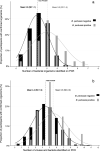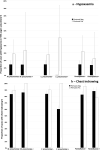Co-detection of Bordetella pertussis and other respiratory organisms in children hospitalised with lower respiratory tract infection
- PMID: 33009451
- PMCID: PMC7532201
- DOI: 10.1038/s41598-020-73462-w
Co-detection of Bordetella pertussis and other respiratory organisms in children hospitalised with lower respiratory tract infection
Abstract
Multiple potential pathogens are frequently co-detected among children with lower respiratory tract infection (LRTI). Evidence indicates that Bordetella pertussis has an important role in the aetiology of LRTI. We aimed to study the association between B. pertussis and other respiratory pathogens in children hospitalised with severe LRTI, and to assess clinical relevance of co-detection. Nasopharyngeal (NP) swabs and induced sputa (IS) were tested with a B. pertussis specific PCR; additionally, IS was tested for other pathogens using a multiplex PCR. We included 454 children, median age 8 months (IQR 4-18), 31 (7%) of whom tested positive for B. pertussis. Children with B. pertussis had more bacterial pathogens detected (3 versus 2; P < 0.001). While B. pertussis showed no association with most pathogens, it was independently associated with Chlamydia pneumoniae, Mycoplasma pneumoniae and parainfluenza viruses with adjusted risk ratios of 4.01 (1.03-15.64), 4.17 (1.42-12.27) and 2.13 (1.03-4.55), respectively. There was a consistent increased risk of severe disease with B. pertussis. Patterns indicated even higher risks when B. pertussis was co-detected with any of the three organisms although not statistically significant. Improving vaccine coverage against B. pertussis would impact not only the incidence of pertussis but also that of severe LRTI generally.
Conflict of interest statement
The authors declare no competing interests.
Figures



References
-
- 1World Health Organisation. Disease burden and mortality estimates. https://www.who.int/healthinfo/global_burden_disease/estimates/en/(2020)
Publication types
MeSH terms
Grants and funding
LinkOut - more resources
Full Text Sources
Miscellaneous

